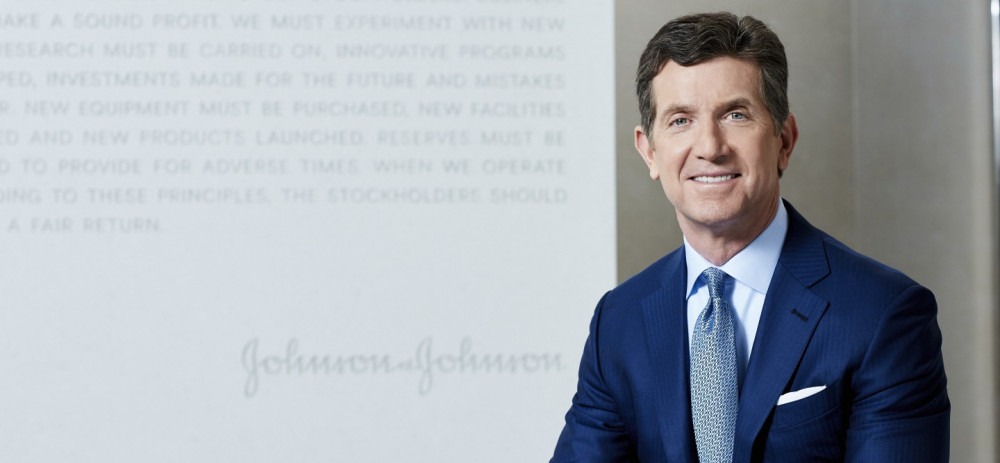
In what Johnson & Johnson CEO Alex Gorsky called a great example for the larger pharmaceutical industry, the company has reached a deal with fellow pharmaceutical giant and oft-rival Merck that will unite the pair’s resources to produce Johnson & Johnson’s new COVID-19 vaccine.
Faced with rising cases of variations and mutations of the virus, Gorsky said Wednesday during a live interview hosted by The Washington Post that it was incumbent for everyone to do everything they can to accelerate vaccine production. Johnson & Johnson’s new deal with Merck came about through collaboration with the U.S. government, which has pledged to make enough vaccine for all American adults by the end of May.
“Two of the largest pharmaceutical companies in the world who are usually competitors are working together on the vaccine,” President Joe Biden said earlier this week. “This is the type of collaboration between companies we saw in World War II.”
While the current goal for Johnson & Johnson’s single dose vaccine is 100 million doses by June, with the help of Merck it hopes to exceed that. The threat faced by COVID-19 has already spurred companies and governments to move at rare speed to respond, and Gorsky noted that a point where every American could realistically be vaccinated is approaching, as issues with supply are finally locked down.
“When we started with this, about 13 months ago, some of the manufacturing facilities we’re now utilizing were literally parking lots,” Gorsky said. “The complexity of bringing up this kind of scale and scope, within this period of time – I don’t think it’s ever been done before in the history of our industry. There’s twists, there’s ups and downs, I think our team has made incredible progress.”
In fact, at the announcement of approval by the Food and Drug Administration (FDA), Johnson & Johnson estimates it was able to ship almost 4 million doses. While momentum is picking up, though, certain questions remain.
One of the critical advantages of the Johnson & Johnson vaccine is that it takes just one dose, unlike vaccines from Pfizer/BioNTech and Moderna. It also produces less side effects and can be stored at refrigerated temperatures rather than frozen. However, it’s overall efficacy is less than those competitors, at around 72 percent for moderate illness prevention in U.S. trials, compared to the others’ 95 percent efficacy. It completely prevents hospitalization and death and was 85 percent effective in blocking severe cases of illness.
Gorsky noted that people cannot know the true comparative efficacy between vaccines until actual head-to-head trials are held. Whereas other vaccines were more focused in their studies, Johnson & Johnson’s incorporated worldwide data, for example, pulling from studies in the U.S., Latin America, Brazil and South Africa.
When asked about the possibility of a second shot or booster to add efficacy to the Johnson & Johnson vaccine, Gorsky noted that trials of approximately 30,000 people are currently underway to assess that possibility, but that the company is pleased with its current efficacy, which still far exceeds the FDA’s 50 percent requirement. The hope is to have further details later this year, but current data suggest that even the single dose’s effects are persistent up to at least 80 days.
“Unfortunately we know that every time this virus is transmitted, that will happen more frequently if people aren’t vaccinated, there’s the risk of it mutating, or slightly changing its form over time, that could make it more transmittable, leading to greater hospitalization or death,” Gorsky said. “The more people we get vaccinated, the less risk.”
Little in the way of research is yet available on the vaccine’s effectiveness in children, either. This is because the initial focus for all vaccines have been on those 18 years or older. Gorsky pointed out here that the vector platform being used for Johnson & Johnson’s vaccine has been previously used among broad age groups when tackling Ebola and HIV, leading to hopes for its capabilities when it comes to COVID-19.
“All the companies, ourselves included, are working on utilization for younger children,” Gorsky said. “Our first step would be ages 12-18, then younger, even women in pregnancy. We’re working with the FDA as we speak, and hope to have results of trials later this year.”
Some trials are already underway, and Gorsky said some results could be seen by the third or fourth quarter of this year.
In the meantime, the collaboration of the Johnson & Johnson-Merck agreement shows that data sharing and manufacturing partnerships between companies may be an increasing possibility. It gives people much greater certainty, according to Gorsky, and shows the path to public-private partnerships that keep innovation alive while helping companies achieve goals they wouldn’t be able to reach on their own.




